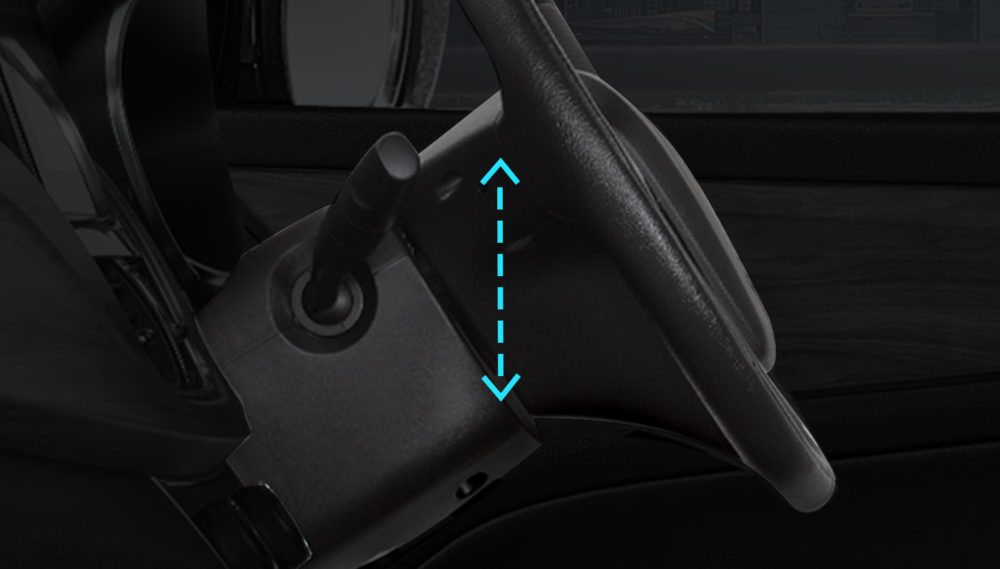Imagine hopping into your car and feeling like you’re in control of a spaceship. The driving experience is comfortable, tailored, and just right for you.
Sounds appealing, doesn’t it? One of the unsung heroes behind this comfort is the tilt steering wheel. But what exactly is a tilt steering wheel, and why should you care about it? As you explore this feature, you’ll discover how it can transform your driving experience by offering enhanced comfort and control.
Dive into this article to uncover how a simple adjustment can make a huge difference in your daily commutes and long drives. Trust us, once you understand the benefits of a tilt steering wheel, you’ll wonder how you ever drove without it.

Credit: wuling.id
Tilt Steering Wheel Basics
The tilt steering wheel is a feature in many vehicles that allows drivers to adjust the angle of the steering wheel to fit their comfort. If you’ve ever felt cramped or strained while driving, this simple adjustment can make a big difference. Understanding the basics of a tilt steering wheel can enhance your driving experience significantly.
What Is A Tilt Steering Wheel?
A tilt steering wheel lets you change the angle of the steering wheel up and down. This feature is especially useful for drivers of different heights. By adjusting the steering wheel, you can find a more comfortable driving position.
Imagine sitting in a car and being able to move the steering wheel closer to your lap or further away. This flexibility can help reduce fatigue during long drives. It also enhances your control over the vehicle.
How Does A Tilt Steering Wheel Work?
Most tilt steering wheels operate via a lever or button. You simply activate the control and adjust the wheel to your preferred position. Once you release the lever or button, the wheel locks into place.
This mechanism is designed to be user-friendly. You don’t need any tools or technical knowledge to make adjustments. It’s as simple as adjusting your car seat or rearview mirror.
Benefits Of Using A Tilt Steering Wheel
Using a tilt steering wheel can greatly improve your driving comfort. Adjusting the wheel to a comfortable angle can help prevent back and shoulder strain. This can be particularly beneficial on long road trips.
It also enhances safety. A properly positioned steering wheel can ensure better control over your vehicle. Additionally, it allows for a clearer view of the road and dashboard instruments.
Personal Experience: The First Time I Used A Tilt Steering Wheel
The first time I used a tilt steering wheel was during a long drive to visit family. I remember feeling uncomfortable and fatigued after just a few hours on the road. Adjusting the steering wheel changed everything.
Suddenly, I felt more relaxed, and driving became less of a chore. That small adjustment made a huge difference. Have you ever experienced something similar?
Why Is A Tilt Steering Wheel Important For You?
Consider how often you drive. Even short trips can become uncomfortable if your steering wheel isn’t set right. A tilt steering wheel allows you to personalize your driving space.
Think about your comfort and safety. Isn’t it worth taking a moment to adjust something that can have such a big impact? Next time you get behind the wheel, take a moment to find your perfect angle.
Benefits For Drivers
Understanding the benefits of a tilt steering wheel can enhance your driving experience. This feature allows drivers to adjust the steering wheel’s angle. It offers various advantages that improve comfort and control while driving.
Improved Comfort
A tilt steering wheel helps drivers find a comfortable position. Adjusting the wheel reduces strain on the arms and shoulders. Long drives become less tiring with this feature. It accommodates drivers of different heights and preferences.
Enhanced Control
Adjusting the tilt gives drivers better control of the vehicle. A well-positioned steering wheel improves maneuverability. It allows for precise steering, especially in tight spots. Drivers feel more confident and secure.
Customizable Experience
The tilt feature allows for a personalized driving setup. Drivers can adjust the wheel to suit their style. This customization caters to individual needs and preferences. It makes the driving experience more enjoyable and tailored.
Mechanics Of Tilt Steering
The tilt steering wheel offers a comfortable driving experience. It allows drivers to adjust the wheel angle to their preference. Understanding its mechanics helps appreciate its functionality.
How It Works
Tilt steering adjusts the wheel’s position vertically. This feature helps align the wheel with the driver’s height. A lever under the steering column controls this adjustment. Pull the lever to unlock the wheel. Move the wheel to the desired angle. Release the lever to lock it in place. The process is straightforward and user-friendly.
Components Involved
Several components make tilt steering work. The steering column is the main part. It connects the wheel to the car’s steering system. A pivot joint allows the wheel to move up and down. The locking lever secures the wheel at the chosen angle. Springs help maintain tension and hold the wheel steady. These components work together seamlessly.
Adjusting The Tilt
Tilt steering wheels allow drivers to adjust the angle of the wheel. This enhances comfort and control. Drivers can easily find the perfect position for their height and seating preference.
Adjusting the tilt of your steering wheel can make a world of difference in your driving comfort. It allows you to find the perfect position for your hands and arms, reducing fatigue and enhancing control. But adjusting it correctly is key to enjoying these benefits. Have you ever found yourself stretching uncomfortably while driving? Or maybe your arms feel cramped after a long drive. Learning to adjust the tilt steering wheel properly can solve these issues and improve your driving experience. ###Steps To Adjust
Adjusting your tilt steering wheel is straightforward. First, locate the lever or knob beneath the steering column. It’s usually on the left side. Pull or push the lever to unlock the steering wheel. This allows the wheel to move up or down. Once unlocked, adjust the wheel to a comfortable height and angle. Your arms should be slightly bent, and your hands should rest naturally on the wheel. After finding the right position, push or pull the lever back to lock the wheel in place. Always make sure it’s firmly locked before driving. ###Common Mistakes
Many drivers forget to lock the steering wheel after adjusting. This oversight can lead to unexpected movement while driving, which is unsafe. Another mistake is adjusting the wheel while driving. This is dangerous and distracts you from the road. Some drivers adjust the wheel too high or too low, causing discomfort. If you find yourself stretching or hunching over, you might need to readjust. Always remember, the goal is comfort and control. If you feel any strain, it might be time to revisit your steering wheel settings. Have you ever made any of these mistakes? Adjusting the tilt steering wheel correctly can enhance your driving experience and keep you safe on the road.Impact On Driver Safety
Safety is a key concern for drivers. Tilt steering wheels significantly enhance driver safety. They allow for better control and comfort. Adjustable angles help drivers find their ideal position. This leads to improved visibility and steering control. Adjusting the wheel reduces strain on the arms and shoulders. This minimizes the risk of accidents. With better ergonomics, drivers can focus more on the road. This ensures a safer driving experience. A comfortable driver is a confident driver. Confidence contributes to safer driving habits.
Ergonomic Advantages
Tilt steering wheels offer ergonomic benefits. They help drivers maintain a healthy posture. Adjustable angles cater to different body types. Drivers can customize their seating position. This reduces stress on the back and neck. Less physical strain means better concentration on driving. Proper posture helps prevent long-term health issues. Ergonomic design is essential for comfort. Comfort leads to safer driving practices.
Reducing Fatigue
Driver fatigue is a common issue. Tilt steering wheels help reduce fatigue. Adjustable positions allow for frequent changes. This keeps muscles relaxed and alert. Less fatigue means better reaction times. Drivers can maintain focus for longer periods. This reduces the likelihood of accidents. Fatigue management is crucial for safety. A well-rested driver is a safer driver.

Credit: www.marketresearchintellect.com
Tilt Steering In Modern Vehicles
Tilt steering wheels have become a standard feature in modern vehicles. They offer drivers the ability to adjust the steering wheel’s angle. This enhances driving comfort and control. Modern technology has expanded the functionality of tilt steering.
Technological Advancements
Today’s tilt steering systems use electronic controls. They allow precise adjustments with minimal effort. Some vehicles offer memory settings for different drivers. This means the steering wheel can adjust automatically to the preferred position. This technology makes driving more convenient.
Integration With Other Features
Tilt steering is integrated with various vehicle systems. In some cars, it works with the seat and mirror settings. When a driver adjusts the steering wheel, seat, and mirrors also shift. This creates a personalized driving experience. Some models link tilt steering with safety features. For instance, the system can adjust for better airbag deployment. These integrations enhance both comfort and safety.
Choosing The Right Tilt Steering Wheel
Choosing the right tilt steering wheel can greatly enhance driving comfort. It allows drivers to adjust the steering wheel angle. This feature helps in reducing fatigue on long drives. Not all tilt steering wheels offer the same benefits. So, understanding what to look for is crucial. Let’s explore the factors and personal preferences to consider.
Factors To Consider
When selecting a tilt steering wheel, consider compatibility. Ensure it fits your vehicle model. This feature enhances safety and functionality. Check the range of tilt adjustment. A wider range offers more flexibility. Materials matter, too. Look for durable materials that offer a good grip. Leather and rubber are popular options. They provide both comfort and control. Also, consider the locking mechanism. A secure lock ensures the wheel stays in place.
Personal Preferences
Personal preferences play a big role in your choice. Some drivers prefer a sporty feel. Others might want a more classic look. Think about the design that suits your style. Color can also be a deciding factor. You might prefer a color that matches your car’s interior. Comfort is key. Test different materials to see which feels best. Remember, you will spend a lot of time holding it. Choose what feels right for you.

Credit: www.youtube.com
Conclusion
A tilt steering wheel enhances driving comfort and control. Adjusting its angle suits your driving posture. This feature reduces fatigue on long trips. It helps drivers of various heights find the best position. Safety improves with better steering control. Many cars now offer tilt steering wheels.
They make driving more enjoyable and personalized. Consider this feature when choosing a vehicle. It’s a simple upgrade with big benefits. A tilt steering wheel is practical for everyday driving. Enjoy a more comfortable journey with this useful feature.
